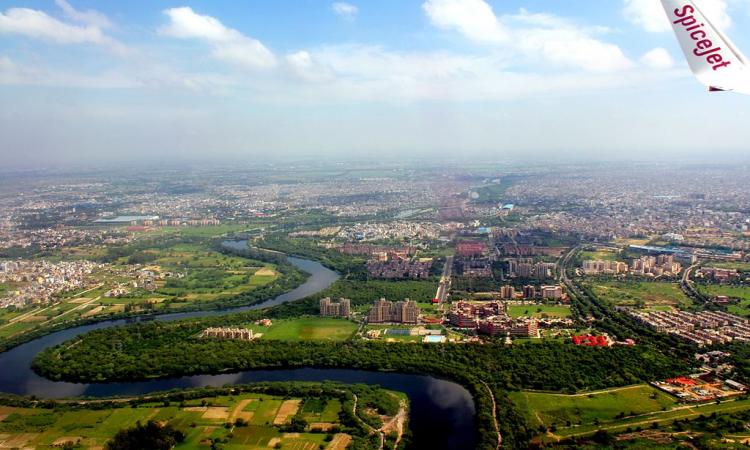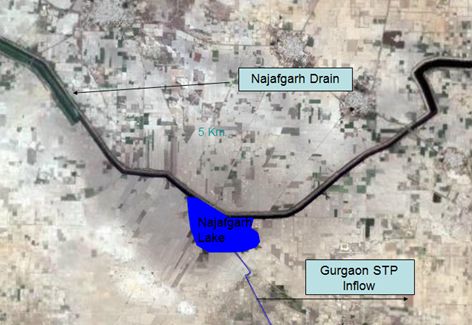
Here’s some news for nature lovers. A dirty drain in Delhi could well be on its way to becoming a bird sanctuary. The Najafgarh drain or nallah that flows through the northwest part of Gurugram is becoming a new habitat for the strikingly tall Greater flamingos, a rosy-white pink billed migratory bird as it passes through southwest Delhi.
“The drain has become a refuge for thousands of wintering waterbirds in recent years. Birds like flamingos, once sighted in Okhla and Sultanpur sanctuary, are giving their traditional habitats a miss,” says Neha Sinha of Bombay Natural History Society. This shift in habitat is not a good sign. “It is an indication of how the advancing urban infrastructure is destroying the wetlands at an alarming rate. It is a matter of concern for the area’s marshlands,” says Pankaj Gupta, an avid birder of the Delhi Bird Foundation. Not just the bird route and the marshy lands, but nearly the entire basin, i.e. the area from where it receives its water, has been altered from its previous state, adding to its woes.
Sinha and Gupta were speaking at a workshop titled Transforming the Najafgarh basin organised by India Water Partnership, Gurugram and INTACH, New Delhi with support from DLF Foundation, Gurugram. The workshop was aimed at identifying the challenges in the rehabilitation of the basin and devising strategies to address the crisis. Not just the bird sanctuary, various issues related to the basin, ranging from climate change, pollution, conservation of water bodies and water governance and management were discussed. The participants came to an understanding that there is a need to focus on the basin as a whole and not just the drain.
The term drain is a misnomer
Najafgarh drain is a continuation of the erstwhile Sahibi river. The drain originates in the Aravali hills in the area that borders Rajasthan and Haryana. Historically, the drain has served as a network to carry stormwater for parts of Rajasthan, Haryana and Delhi. Now rampant pollution and untreated sewage from Gurugram-Delhi are choking it and the Yamuna river to which it outfalls.

“Seventy percent of Delhi’s drainage network lies in the Najafgarh basin. The Najafgarh river was channelised in 1978 with the objective of integrating it with the stormwater drainage system of the city and was renamed Najafgarh drain,” says Dr Veena Khanduri, executive director, India Water Partnership, a nonprofit organisation working on water.
Currently, the 41-km-long Najafgarh drain is the largest sewage carrying drain in the capital. It is joined by 22 smaller feeder drains. “Together, they discharge about 2,000 million litres of wastewater a day into the river Yamuna, of which 70 percent is untreated,” says Khanduri.
“Floodplain encroachment and its alteration due to rapid urbanisation of Gurugram and Delhi are major concerns. Excessive flooding of the Delhi-Gurugram Expressway last year that caused a 24-hr traffic jam is a result of the issues concerning the drain,” says Vinay Pratap Singh, deputy commissioner, Gurugram.
“Gurugram’s meager water availability poses a severe challenge to its water security,” says Col Prakash Tiwari, executive director, corporate social responsibility, DLF Foundation. The specific problems that need to be addressed are “unplanned drainage system leading to flooding and clogging of roads, unsafe drinking water, inadequate waste management systems and more broadly, the absence of social infrastructure facilities,” says Col Tiwari.
A key problem related to the drain is the multiplicity of agencies dealing with it. In Delhi alone, there is the irrigation and flood control department, Delhi Development Authority, Municipal Corporation of Delhi, public works department and Delhi Jal Board that have been staking claim, leading to poor accountability,” says environment secretary (Delhi), Keshav Chandra who is also CEO, Delhi Jal Board.
Najafgarh lake loses its character
“Rainwater accumulating in the Najafgarh lake had been recorded to have occupied more than 300 square kilometres in many years till the 1960s. After that, the flood control department of Delhi kept widening the portion of Najafgarh drain below the lake to save Delhi from floods and eventually drained the once huge and ecologically rich lake,” says Bhatnagar.
Yet, floods are common in the basin, especially in Gurugram. Severe floods have occurred in the basin in the past, notably in the year 1967 and consecutive floods in the years 1975-1977 as well as in 1995-1996. “The effect of floods is worsened by anthropogenic activities such as infrastructure development, which obstructs the natural flow of water. This is especially true for the Badshapur drain that outfalls into the Najafgarh drain. Infrastructure development in the catchment area of the drainage basin increases the runoff generated from the region. This has led to over utilisation of the drain, the effect of which is exacerbated by poor management of the drain itself. The floods have resulted in severe drinking water and soil contamination in the region,” says Manu Bhatnagar, INTACH, a non-profit working on art and cultural heritage.
‘Developing’ the wetland and the basin
Making a case for “public-private participation” to rejuvenate the Najafgarh drain, the Union Minister of State for Urban Development, Rao Inderjit Singh says that the “government and private companies should come together to rejuvenate the basin.” To have a predictable inflow of capital investments in the megacity, the natural environment, which is a condition for production, needs to be relatively stable. Col Tiwari stresses the need to “insure investments of Gurgaon and Delhi against water scarcity”.
The drain forms a rich natural habitat for numerous species of plants and animals. “The Najafgarh drain has the potential to be developed as a lake which can be utilised for recreational activities as well as a water recharging area,” says Bhatnagar. INTACH has filed a public interest litigation with the National Green Tribunal on the need to notify the Najafgarh lake as a wetland.
“We can have a multipronged approach of creating a major biodiversity habitat, a recreational water zone and an 80-km navigable waterway. This can provide 30 million gallons per day of water to Gurgaon and Delhi,” says Tiwari.
“There is a need to reconnect the larger catchment to the water body and accommodate higher flows during floods. Ecologically-designed, easy-to-maintain water-based landscapes should be created for public use. In doing so, we restore and enhance biodiversity locally. Corridors should be created for enhanced mobility for non-motorised modes,” says Keshav Chandra.
Chandra says urban planning is of utmost importance and natural, restored and constructed ecosystems within cities can provide the substructure to support sustainable urban water drainage and storage.
A proposal for development and beautification of the lakefront as a promenade for visitors with a buffer zone as suggested by INTACH, however, may lead to clashes. The “notification of a wetland would become a site for conflict given the adverse impact on livelihoods of rural farmers,” says S.S. Rawat, executive engineer of the irrigation department, Haryana. “Proposed real estate development around the basin shows the utilitarian view of Najafgarh basin and ignores its multiple dimensions,” says secretary general of the International Commission on Irrigation and Drainage, Avinash Tyagi.
There is a need to restore the basin characteristics to a reasonable extent. And for that, there needs to have a multi-stakeholder approach for Najafgarh basin rejuvenation, according to Suresh Babu, director, River Basins & Water Policy at World Wildlife Fund for India. Babu says, “A basin committee should be embedded in the district administration. It should be three-tiered: district, block and village. Avenues should be created for stakeholder participation through meetings, marches, choupals to anchor dialogues and action, develop basin health assessment and citizen report cards. All data relating to the Najafgarh basin should be in the public domain, and should be accessible to all citizens.”
/articles/najafgarh-seeks-attention